How to Get Rid of Bed Bugs on Cats
Lots of people and houses are suffering from those slimy, disgusting, filthy bugs.
That's where such questions arise: How to get rid of silverfish bugs and how to do it fast? What method to choose? Will it be safe?
The answers to these and other questions you'll find in the following article.
5 Easy Steps on How to Get Rid of Silverfish Bugs
Silverfish bugs are pesky little critters that can make your home incredibly uncomfortable. They love to crawl into the tiniest spaces and eat everything in sight, including our food. If you've been seeing silverfish around your house lately, it's time to take action!
Here are 5 steps on how to get rid of these annoying pests for good:
-
Identifying
 Identify where the silverfish bugs are coming from and seal up any cracks or holes in your home.
Identify where the silverfish bugs are coming from and seal up any cracks or holes in your home. -
Get Rid of Clutter
 Keep food sealed uptight, get rid of clutter around the house, including old clothes, shoes, and books. Vacuum the house regularly.
Keep food sealed uptight, get rid of clutter around the house, including old clothes, shoes, and books. Vacuum the house regularly. -
Cut Back on Moisture
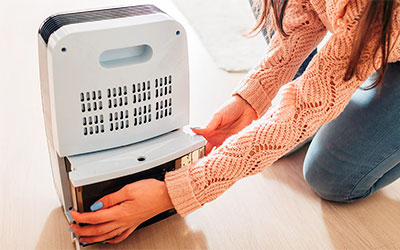 Don't leave wet clothes laying around, install a dehumidifier if necessary.
Don't leave wet clothes laying around, install a dehumidifier if necessary. -
Use Silverfish Killer Products
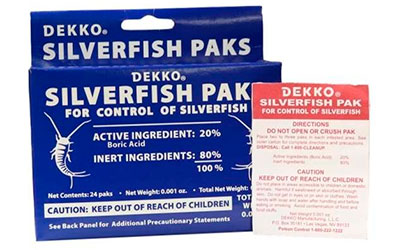 Click here for more information about the best silverfish killer products.
Click here for more information about the best silverfish killer products. -
Clean Up
 Clean your kitchen often with vinegar or bleach to prevent bugs from living there. Clean up after yourself - don't leave dishes in the sink or dirty clothes lying around.
Clean your kitchen often with vinegar or bleach to prevent bugs from living there. Clean up after yourself - don't leave dishes in the sink or dirty clothes lying around.
Keep reading for more helpful tips!
Bugs won't magically disappear unless you do something about it.
To cope with the problem successfully one should understand what exactly you deal with. You should also know their breeding and living patterns to make your home "inhospitable" to them.
What Are Silverfish Bugs?
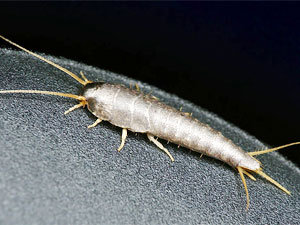 These are about 1/2 inch bluish-silver wingless insects with hard exoskeleton. They look like fish and their movements are very similar. They have 2 long antennas on their head and 3 prominent "tails" on the rear.
These are about 1/2 inch bluish-silver wingless insects with hard exoskeleton. They look like fish and their movements are very similar. They have 2 long antennas on their head and 3 prominent "tails" on the rear.
Females' egg numbers vary. Depending on species, their quantity may range from 2 to 20 eggs per day. Silverfish can lay eggs at any season of the year and grow from larva to adult in 3-4 months.
Silverfish feed on mold, fungi, and carbohydrates (such as sugars, starch or cellulose). This means that your food (especially dry foods), clothes, shampoos, soaps, books, wallpaper, plants, and many other things are in danger.
Though the insects may be found almost anywhere, they prefer dark, moist, moderate temperature areas (60-80 degrees Fahrenheit) and places with good sources of food. Unless the food is gone, they remain close to its supply.
Therefore, the usual silverfish habitats are:
- bathrooms,
- kitchens,
- laundry rooms,
- attics,
- basements.
They are commonly found in/under sinks, bathtubs, in storage boxes, bookcases, old stacks of papers (magazines, newspapers, etc.), on closet shelves, behind wallpaper, wall voids, window or door frames, and baseboards.
The bugs just love the taste of starch in book bindings, paper on which there are glue or paste, various fabrics, bathroom products, cereals, flour, crumbs, and plant materials.
Silverfish Elimination
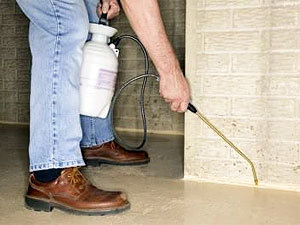 Killing silverfish bugs is not an easy thing, since they hide in different dark, protected places and reproduce very quickly. They are nocturnal (i.e. they're mostly active at night) and may remain unnoticed for a long time.
Killing silverfish bugs is not an easy thing, since they hide in different dark, protected places and reproduce very quickly. They are nocturnal (i.e. they're mostly active at night) and may remain unnoticed for a long time.
Thus, the majority of homeowners detect them by their cast skins, tiny pepper-like feces, or feeding damage (e.g. small holes in wallpaper, clothing, cereal boxes, yellowish stains on fabric) when the infestation is already well established.
The fact is that most people give up trying to eliminate silverfish at first failure. But you should be persistent! Not taking action is a poor decision. You don't want these creepy insects scurrying up in your bathroom, kitchen, or your BEDROOM, do you?
Ways of Silverfish Pest Control
There are two principal ways of silverfish control: natural and chemical. Both of them may be effective, but chemical agents are usually much more costly and harmful.
Choose natural home remedies to get rid of silverfish.
Natural means are safe for you, your children and pets. Besides, they offer a wide range of solutions for these bugs.
You may also use different traps that can be bought at a store or made at home.
Natural Silver Fish Bugs Exterminators
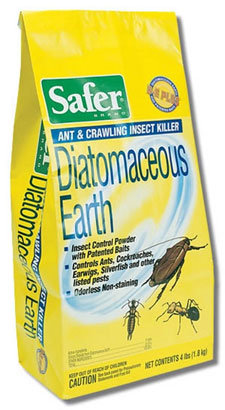 First of all, determine the places of infestation. It is not too difficult – they are always near their food. Secondly, select the product that is more appealing to you.
First of all, determine the places of infestation. It is not too difficult – they are always near their food. Secondly, select the product that is more appealing to you.
Here is a list of available solutions: citrus sprays, spices, diatomaceous earth, mothballs, lavender oil, cucumbers, cedar shavings.
- Citrus sprays. These sprays smell like citrus and are specifically manufactured to eliminate bugs like silverfish which are repelled by the scent. Apply it generously in the alleged places of infestation. Don't use citrus smelling cleaning sprays; they are not organic and will be of no help.
- Spices. They don't like strong scents of bay leaves, sage, and whole cloves (not ground!). Place the spices in porous sachets where the insects appear. It can help deter and discourage them from coming back.
- Diatomaceous earth (food grade). It is a white powder that dehydrates silverfish and other bug pests and causes their death. Dust all areas where they can hide and they will die simply from walking through it. Diatomaceous earth for silverfish is efficient as long as it is dry. Though the powder is lethal to pests, it's non-toxic to people and pets.
- Mothballs. The bugs can't stand their smell either. Place mothballs wherever they are seen frequently.
- Lavender oil. Silverfish are repelled by its scent and stay away. It proved to be a good method of clearing them out of your home. Mix a teaspoonful of concentrated lavender oil in 1/2 a small spray bottle of water. Wipe down the walls with the mixture, spray it onto the carpet, around the skirting boards, cupboard doors, pieces of furniture and other items at your home. Let them dry. Be sure to refresh the smell from time to time. Don't apply it to delicate fabrics, as they can be damaged.
- Cucumbers. The scent of cucumbers is a nice repellent for silverfish. Cut a cucumber into thick slices and put them everywhere the pests may be hiding. Replace the slices once they dry up.
- Cedar shavings. Cedar pieces or shavings should be also helpful at getting rid of them.
- Silverfish are known to like damp areas (75 to 95% humidity), that's why it is recommended to reduce it to about 50%. This can be done with the help of dehumidifiers and fans. Fix everything that leaks, minimize available water, ventilate the attic and closed rooms.
- Caulk cracks and crevices on walls, floors, and holes around pipes to prevent the insects from using them as an entrance.
- Inspect and clean ALL your possessions, including the contents of boxes, wardrobes, cupboards, book shelves, clothing, etc.
- Put all possible food sources into plastic air-proof containers.
- Vacuum, mop and dust your house frequently to remove eggs.
- Repair or remove wallpaper.
Baits & Silverfish Traps
Numerous traps are also non-chemical methods of eradicating the little buggers. They are very cheap and safe. There are some examples of such traps below.
Moisten and roll up newspapers, tie them with elastics, and leave them out overnight to catch silverfish. The next morning either burn the newspapers or dump them into a trash can outside the house since they should be full of "prisoners". Repeat the procedure every night until you no longer find any insects.
Take a jar or a glass container and cover the outsides with masking tape. Put some bread in it or fill it halfway with water and 2-3 teaspoons of sugar as bait. Place the trap in a common infested area. The bugs climb up the masking tape, fall inside the jar, and die because they are unable to climb up the slick sides and escape.
General sticky traps are simple but effective and can be bought at a local hardware store. The traps attract pests and they get stuck.
Starchy food items or moist cotton can be also used as baits.
Chemical Silverfish Extermination
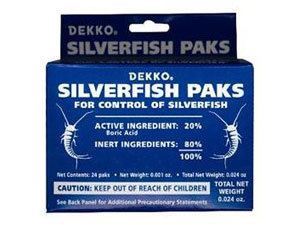 If you decided to continue a chemical route, be prepared to pay a lump sum of money either for hiring a professional extermination company or buying expensive silverfish pesticides. But none of them can address an entire infestation and guarantee complete silverfish eliminating.
If you decided to continue a chemical route, be prepared to pay a lump sum of money either for hiring a professional extermination company or buying expensive silverfish pesticides. But none of them can address an entire infestation and guarantee complete silverfish eliminating.
The most common chemical silverfish exterminator is liquid pyrethrin. Spray it into the cracks around baseboards, doors, and windows. This method will kill adult silverfish but won't kill the eggs.
One more solution to the problem is boric acid. Though it is a natural insecticide, it can be toxic.
Sprinkle a small amount of powder around the infested areas. If it gets damp, just reapply.
Boric acid is effective in killing not only adult silverfish but also hatching nymphs.
Click here for more information about the best silverfish killer products.
- Pesticides are potentially dangerous to mammals.
- Boric acid is toxic when ingested or inhaled.
- Use a disposable face mask to cover your nose and mouth while applying pyrethrin or boric acid.
- Avoid applying insecticides near food, food utensils, or food preparation surfaces.
- Keep your children and pets away from these substances.
- Read and follow the insecticide directions for use very carefully.
Addressing silverfish infestation swiftly is extremely important because they reproduce very fast and are much more intrusive than most people think. If left untreated, the insects can cause costly damage to your home and make you feel nervous. To exterminate these bugs, you need to alter the conditions that make your home inviting to them.
Choose natural methods that kill the whole generation of silverfish, but are secure for humans and animals. Be persistent and don't expect overnight results.
The process is quite tiresome and takes some time to achieve permanent elimination, so give the method a couple of tries and never forget about sanitation. This will prevent reinfestation and save you from many problems.
Questions & Answers
Is it bad to have silverfish?
Silverfish bugs are not harmful to humans, but they can be very bothersome. They will feed on the glue and paper in your bookshelf or clothing you put out for drying. It is important to know that silverfish bugs do not live outside of people's houses! They only infest homes that have light fixtures with old bulbs (which emit a lot of heat) nearby, unvented areas behind baseboards near heating vents, under sinks where pipes enter from outdoors, inside damp places such as bathrooms or laundry rooms with leaky faucets; kitchens beneath cabinets filled with cleaning supplies and other items stored close together. If left unchecked these pesky pests will multiply quickly over time because their main food source is fungus growing on moist surfaces.
Where does silverfish bugs come from?
The silverfish bug does not originate from one single major country. It is a worldwide problem, however, the number of infestations will vary around the world. It is difficult to establish just where these bugs originated because they existed for such a long time before any records were made and were established before most forms of communication existed. There are also many different countries that refer to them by different names, which would make it even more difficult to find an origin point.
Although its origin is unknown, Silverfish is typically an indoor pest and infestation usually occurs just after the tenants have moved in or completed a construction task that has resulted in increased moisture levels such as painting. Their prime food source outdoors is fungi on wood but they can survive on other substances such as book bindings and dead skin cells from humans which causes them to move into human dwellings seeking these goodies.
What scents do silverfish hate?
Silverfish are usually attracted to ammonia, and so any house cleaners with this scent have a good chance of deterring them. Similarly, lavender has been shown to be an effective deterrent for silverfish.
Mothballs can also keep silverfish away because they dislike the smell. I'm not sure if you could call it "liking" these smells but they work effectively in getting rid of the pesky little creatures nevertheless!
You can find further details of Bugs Control here.
How to Get Rid of Bed Bugs on Cats
Source: https://pestkill.org/insect/bugs/silverfish/